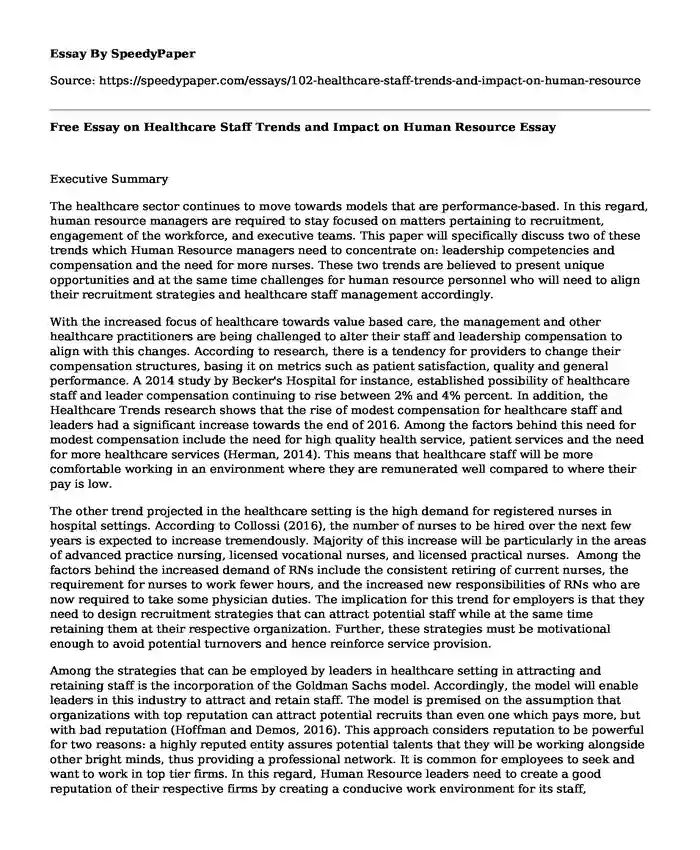
| Type of paper: | Essay |
| Categories: | Health and Social Care Human resources Medicine |
| Pages: | 3 |
| Wordcount: | 685 words |
Executive Summary
The healthcare sector continues to move towards models that are performance-based. In this regard, human resource managers are required to stay focused on matters pertaining to recruitment, engagement of the workforce, and executive teams. This paper will specifically discuss two of these trends which Human Resource managers need to concentrate on: leadership competencies and compensation and the need for more nurses. These two trends are believed to present unique opportunities and at the same time challenges for human resource personnel who will need to align their recruitment strategies and healthcare staff management accordingly.
With the increased focus of healthcare towards value based care, the management and other healthcare practitioners are being challenged to alter their staff and leadership compensation to align with this changes. According to research, there is a tendency for providers to change their compensation structures, basing it on metrics such as patient satisfaction, quality and general performance. A 2014 study by Becker's Hospital for instance, established possibility of healthcare staff and leader compensation continuing to rise between 2% and 4% percent. In addition, the Healthcare Trends research shows that the rise of modest compensation for healthcare staff and leaders had a significant increase towards the end of 2016. Among the factors behind this need for modest compensation include the need for high quality health service, patient services and the need for more healthcare services (Herman, 2014). This means that healthcare staff will be more comfortable working in an environment where they are remunerated well compared to where their pay is low.
The other trend projected in the healthcare setting is the high demand for registered nurses in hospital settings. According to Collossi (2016), the number of nurses to be hired over the next few years is expected to increase tremendously. Majority of this increase will be particularly in the areas of advanced practice nursing, licensed vocational nurses, and licensed practical nurses. Among the factors behind the increased demand of RNs include the consistent retiring of current nurses, the requirement for nurses to work fewer hours, and the increased new responsibilities of RNs who are now required to take some physician duties. The implication for this trend for employers is that they need to design recruitment strategies that can attract potential staff while at the same time retaining them at their respective organization. Further, these strategies must be motivational enough to avoid potential turnovers and hence reinforce service provision.
Among the strategies that can be employed by leaders in healthcare setting in attracting and retaining staff is the incorporation of the Goldman Sachs model. Accordingly, the model will enable leaders in this industry to attract and retain staff. The model is premised on the assumption that organizations with top reputation can attract potential recruits than even one which pays more, but with bad reputation (Hoffman and Demos, 2016). This approach considers reputation to be powerful for two reasons: a highly reputed entity assures potential talents that they will be working alongside other bright minds, thus providing a professional network. It is common for employees to seek and want to work in top tier firms. In this regard, Human Resource leaders need to create a good reputation of their respective firms by creating a conducive work environment for its staff, motivating them and even providing training opportunities.
Considering the high rate of staff turn-over, it becomes important for healthcare organizations to look for means of retaining its employees. This is particularly those with exceptional performance and dedication. According to Dessler (2015), employee retention is one of the most critical factors for the success of any entity including for healthcare. Enhancement of retention can enable an organization to reduce turnover and hence avoid the high cost involved in hiring new employees occasionally.
References
Collossi, B. (2016). 2016 National Healthcare Retention & RNStaffingReport. NSI Nursing Solutions, Inc
Dessler, G. (2015). Human Resource Management. (14th ed). Upper Saddle. River, N. J: Pearson
Hoffman, L., and Demos, T. (2016). Goldman Sachs Has a New Model. The Wall Street Journal.
Oct. 31, 2016
Herman, B. (2014). The Great Pay Debate: 5 Hospital Executive Compensation Trends for 2014.
Becker Hospital Review January 28, 2014
Cite this page
Free Essay on Healthcare Staff Trends and Impact on Human Resource. (2018, Feb 04). Retrieved from https://speedypaper.com/essays/102-healthcare-staff-trends-and-impact-on-human-resource
Request Removal
If you are the original author of this essay and no longer wish to have it published on the SpeedyPaper website, please click below to request its removal:
- Free Essay with Poem Analysis: Ode To A Nightingale by John Keats
- Essay Example: Short Primary Sources about Chinese Immigrants
- Genocide in the 20th Century, Essay Sample in History
- Essay Sample on High Temperatures vs. Man Power in the UAE
- Essay Sample on Antioxidants Role in Disease
- Strategic Human Resource Management - Free Paper Sample
- Stroke Recovery - Free Paper Example
Popular categories




